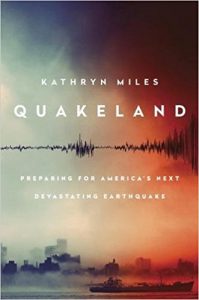Book Review: Quakeland
/Quakeland: On the Road to America's Next Devastating Earthquake
by Kathryn Miles
Dutton, 2017
The sub-title of Kathryn Miles' new book Quakeland is, unfortunately, well-chosen: “On the Road to America's Next Devastating Earthquake” subtly but unmistakably underscores the flat inevitability of catastrophe – the process being described isn't an open-ended quest; it's a journey to a fixed destination. Miles, a journalist who wrote a gripping account of Hurricane Sandy, is equally readable in these pages, but the end result of reading Quakeland is infinitely darker: underneath the ground and far below the worry-radar of most Americans, thousands of hurricanes lie in wait.
In order to lay her scene properly, Miles describes in captivating detail what anybody who's ever experienced an earthquake will remember until they day they die: how mind-blankingly terrifying it is to have the ground under your feet buck and squirm like an angry living thing that wants to be rid of the burden of you. Fires and ocean storms can be fought; tornadoes can be avoided; the sensation of complete helplessness they engender is unique to earthquakes. Always close at hand in Miles' exposition is the sheer power of the phenomenon, which handily exceeds the vocabulary necessary to describe it:
The last remaining survivors of the 1906 San Francisco earthquake died years ago. When most Americans think about California quakes, they think about Loma Prieta – a mere 6.9 – or the 1994 Northridge that registered just a 6.4. The [hypothetical doomsday-level] Shakeout scenario is over 30 times stronger than either of those. It's difficult to comprehend the significance of that. The largest thermonuclear bomb ever made was the Soviet Union's Tsar Bomba. It had the explosive power of 3,800 Little Boys – the bomb that was detonated over Hiroshima. In terms of total energy released, Tsar Bomba is only the equivalent of a magnitude 7.0 earthquake. We don't have an analogy for what a M 7.8 bomb would look like: it's just too big.
When roads are collapsing like heated cake layers and buildings are dancing across highways, all anyone can do is watch and hope that dumb luck lets you survive. The only way to deal with earthquakes is to prepare for them, and Miles spends a good deal of her book investigating such preparations and talking with the experts who devise and implement them, or try to.
This makes for almost impossibly grim reading. Thousands of seismic fault lines criss-cross the continental United States. They run underneath farmland, urban population centers, and more nuclear power plants than any reader will want to think about. Miles talks to people who are experts on every aspect of earthquakes, and over and over in the course of the book, the refrain of complete unpreparedness is sounded. Earthquakes are common in the United States (made more common in some areas by fracking), but their frequency and severity are best measured on a spectrum that's not natural to short-sighted humans, as one volcanologist tries to clarify for Miles:
“Look,” he says, sitting at his office in Menlo Park, California. “Imagine you're a mayfly born on a river in Colorado. You're around for a day. You mate and you die. Do you believe that there's such a thing as a snow storm? As war? That's stuff you're never going to experience. Humans are like that with respect to earth processes. As a species, we woke up 5000 years ago. We didn't start really taking notes until a hundred years ago or so. We're trying to figure out things that are 10,000 times older than our collective consciousness. We're not opening our eyes and looking around, and yet we expect to have all the answers.”
Quakeland will leave its readers with extremely heightened feelings of horror and helplessness, and those feelings derive not just from the inevitability of big quakes in the near future but from the complete lack of readiness at every level of American society. It would be hard to imagine a more vividly readable extended warning than this book by Kathryn Miles, but Quakeland makes one conclusion all but inescapable: nobody's listening.

